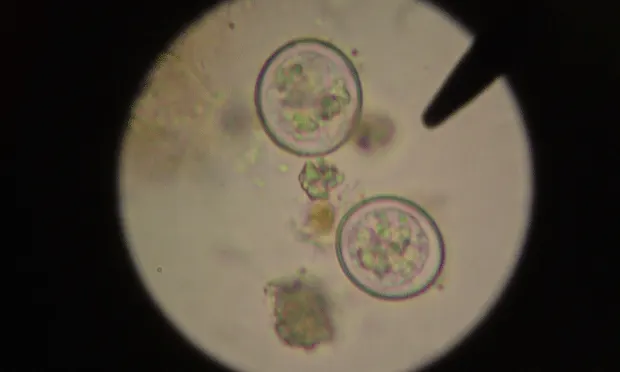Differentiation of Reptilian Parasites & Pseudoparasites

Reptiles are hosts to a variety of parasites, many of which can be recognized by the clinician who is able to identify mammalian parasites.
Examination Basics
As with mammals, you should apply your basic knowledge of light microscopy techniques when examining the feces of reptiles. Direct wet mounts, flotation concentration, and stained smears all are useful in parasite detection. When viewing a slide, adjust the focus and intensity of light to enhance different features. A micrometer is helpful, and you should remain mindful of the level of magnification. A few basic features of ova and cysts may be observed and recorded to help sort your findings into categories; some common features are listed in the Table.
Identification Difficulties
Many kinds of protozoal cysts are impossible to differentiate in the typical clinical practice setting. With metazoan parasites in a single life stage, clinicians may have difficulty identifying below the level of family or genus. Other parasites, however, are host-specific and can be readily identified from a single observation.
In practice, the precise identification of a parasite may be less important than determining if the organism in question is likely to be a pathogen, if it is likely to have a direct or indirect life cycle, if it responds to chemotherapeutics, and what sanitation is appropriate to prevent its spread or reinfestation.
Related Article: Evaluating Blood Films in Reptiles
Treatment
If treatment is necessary, antiparasitic drugs alone are insufficient. Nutritional support and fluid therapy are critical, and antibiotic therapy to prevent severe gastroenteritis may be warranted, depending on the condition of the patient. A thorough review of hygiene practices, food sources, and quarantine procedures should always accompany a diagnosis of parasitic disease.
The pictures presented are of regularly occurring parasites and pseudoparasites. Choose from the listed organisms; each description corresponds with only one picture. See the photos and descriptions towards the end of the article for answers.
Related Article: Does That Snake Have Cryptosporidiosis?
NOTE: Drug dosages provided are empirical and have not been proven effective in all species of reptiles.